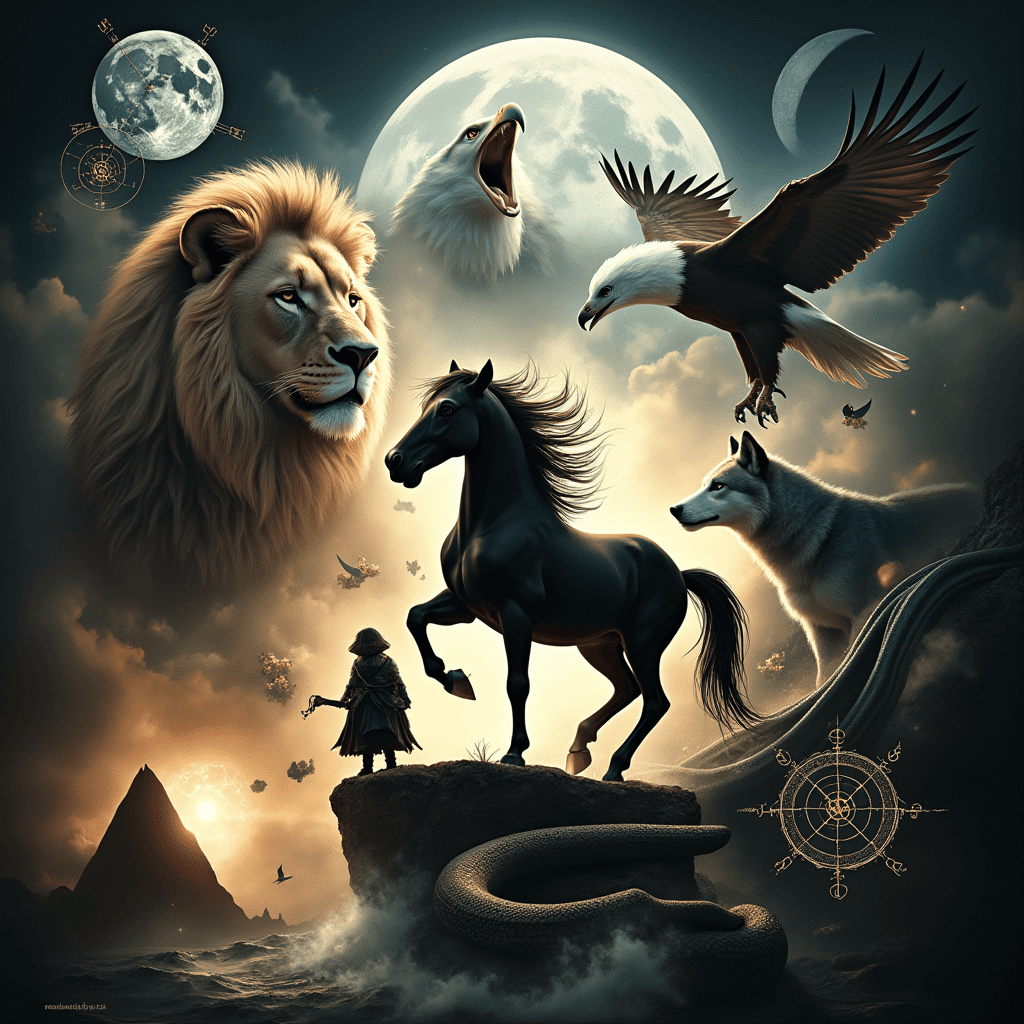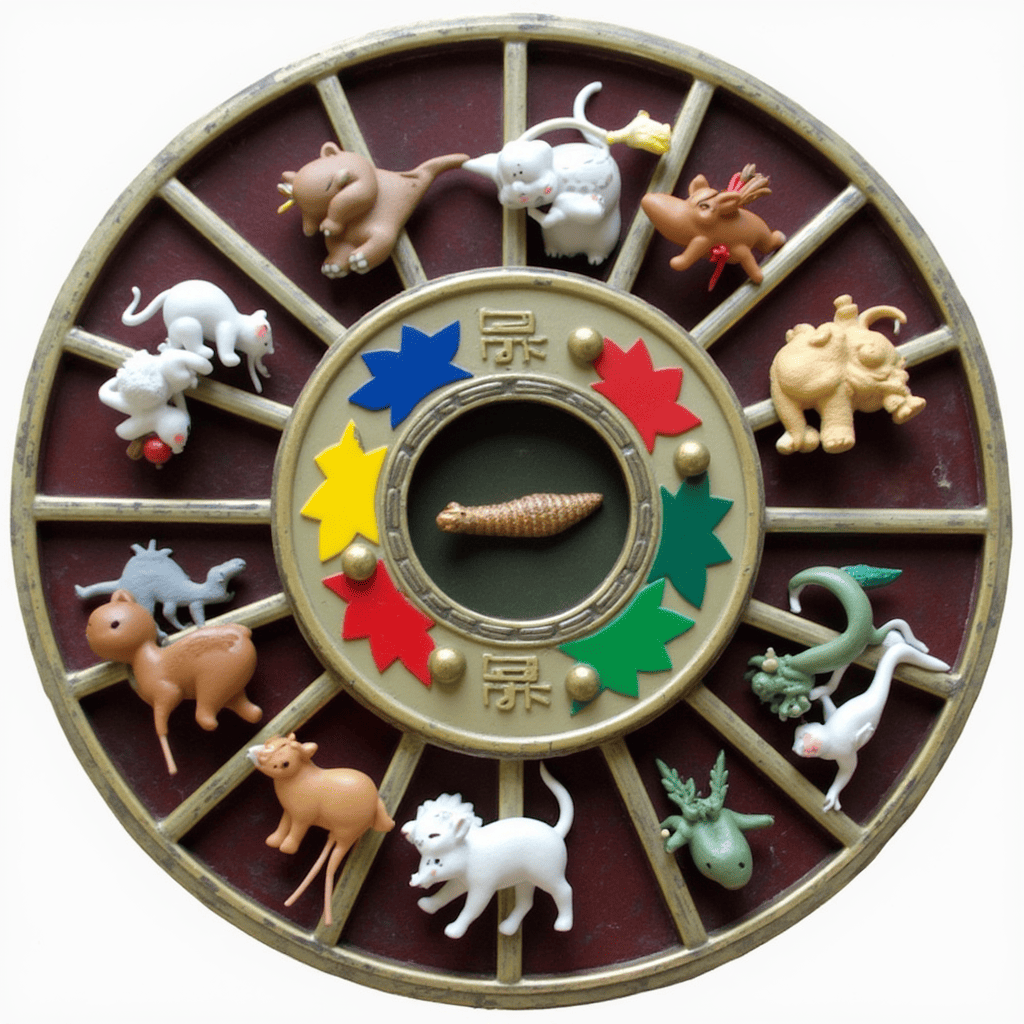The History of Animal Symbolism: How Ancient Civilizations Used Animals
Animals in Ancient Egypt
Ancient Egyptians held animals in high regard, often associating them with gods, goddesses, and cosmic forces. Animals were seen as bridges between the human and divine realms, embodying traits that humans aspired to or revered.
- The Cat as a Symbol of Protection and Divinity
Cats were sacred in ancient Egypt, closely associated with the goddess Bastet, who represented home, fertility, and protection. Egyptians believed cats warded off evil spirits and brought good fortune. Killing a cat, even accidentally, was considered a grave crime. Cats were often mummified and buried with their owners to ensure protection in the afterlife. Their grace, independence, and hunting prowess made them symbols of both domestic harmony and divine power. - The Scarab Beetle and Its Connection to Rebirth and the Sun
The scarab beetle, particularly the species Scarabaeus sacer, was a powerful symbol of rebirth and regeneration. It was associated with the sun god Ra, who rolled the sun across the sky each day, much like the beetle rolls balls of dung. The scarab’s life cycle, emerging from the ground, symbolized resurrection and eternal life. Scarab amulets were placed on mummies to ensure safe passage into the afterlife, emphasizing their role as a symbol of transformation and renewal.
Animals in Greek and Roman Mythology
Greek and Roman mythologies are rich with animal symbolism, often linking creatures to gods, heroes, and moral lessons. Animals were seen as manifestations of divine will or as messengers between the mortal and immortal worlds.
- The Owl as a Symbol of Wisdom (Athena/Minerva)
The owl, particularly the little owl (Athene noctua), was sacred to Athena, the Greek goddess of wisdom, strategy, and warfare. The Romans adopted this symbolism, associating the owl with Minerva. The owl’s ability to see in the dark made it a symbol of insight, knowledge, and the ability to uncover hidden truths. It was often depicted on coins and in art as a companion to these goddesses, representing intellectual and spiritual enlightenment. - The Eagle as a Representation of Power and Zeus/Jupiter
The eagle was the sacred bird of Zeus (Jupiter in Roman mythology), the king of the gods. It symbolized strength, authority, and divine favor. The eagle’s ability to soar high in the sky connected it to the heavens, making it a natural emblem of power and supremacy. Roman legions carried eagle standards (aquilae) into battle, believing the bird would bring them victory and protection. The eagle also represented the connection between the mortal world and the divine, as it was believed to carry messages to and from the gods.
Animals in Native American Traditions
Native American cultures have deep spiritual connections to animals, viewing them as teachers, guides, and protectors. Animals are often seen as embodying the qualities humans need to survive and thrive in harmony with nature.
- The Wolf as a Symbol of Loyalty and Intuition
The wolf holds a special place in many Native American tribes, symbolizing loyalty, family, and intuition. Wolves are pack animals, and their strong social bonds made them symbols of community and cooperation. Tribes like the Cherokee and Lakota saw the wolf as a spiritual guide, teaching humans the importance of trusting their instincts and working together. The wolf’s howl was also believed to carry messages from the spirit world, making it a bridge between the physical and spiritual realms. - The Bear as a Representation of Strength and Healing
The bear is revered in Native American traditions as a symbol of strength, courage, and healing. Many tribes, such as the Navajo and the Zuni, associate the bear with medicine and introspection. Bears hibernate during the winter, emerging in the spring, which symbolizes renewal and transformation. The bear’s physical power and protective nature also made it a symbol of leadership and resilience. Shamans often called upon the bear spirit for guidance in healing rituals and spiritual journeys.
Animals in Eastern Cultures
Eastern cultures, including Chinese, Hindu, and Buddhist traditions, have long used animals to symbolize virtues, cosmic forces, and spiritual ideals. These symbols are deeply embedded in art, religion, and daily life.
- The Dragon in Chinese Culture as a Symbol of Power and Luck
In Chinese culture, the dragon is a celestial creature symbolizing power, strength, and good fortune. Unlike Western dragons, which are often depicted as malevolent, Chinese dragons are benevolent beings associated with water, rain, and fertility. They are also symbols of the emperor’s authority and the balance of yin and yang. During festivals like Chinese New Year, dragon dances are performed to bring prosperity and ward off evil spirits. The dragon’s mythical nature connects it to the divine, making it a powerful symbol of transformation and success. - The Elephant in Hinduism and Buddhism as a Symbol of Wisdom and Stability
In Hinduism, the elephant-headed god Ganesha is one of the most beloved deities, representing wisdom, intellect, and the removal of obstacles. Elephants are also associated with the god Indra, the king of the heavens, symbolizing royalty and strength. In Buddhism, the white elephant is linked to the Buddha’s birth, symbolizing mental strength, patience, and compassion. Elephants are seen as gentle giants, embodying both physical power and emotional stability, making them revered symbols in spiritual practices.
Spirit Animals: Discovering Your Inner Guide
What Are Spirit Animals?
Spirit animals are believed to be guides or protectors that offer wisdom, support, and insight into our lives. They are deeply rooted in shamanic traditions and spiritual practices across the world.
- Definition and Origins of the Concept
The concept of spirit animals originates from indigenous and shamanic traditions, where animals are seen as spiritual allies. These animals are thought to embody specific traits or lessons that individuals need at certain points in their lives. Spirit animals are not chosen but are believed to choose us, appearing in dreams, visions, or recurring encounters. - How Spirit Animals Differ from Totem Animals
While spirit animals are personal guides that may change throughout one’s life, totem animals are often tied to clans, families, or tribes and represent collective traits or values. Totem animals are more permanent and are passed down through generations, whereas spirit animals are more fluid and individualized.
How to Discover Your Spirit Anima
Discovering your spirit animal requires introspection, mindfulness, and openness to signs from the natural world.
- Meditation and Dream Interpretation
Meditation is a powerful tool for connecting with your spirit animal. By quieting the mind and focusing on your breath, you can invite your spirit animal to reveal itself. Dreams are another common way spirit animals communicate. Keeping a dream journal and reflecting on recurring animal imagery can help you identify your guide. - Paying Attention to Recurring Animal Encounters in Daily Life
If you notice a particular animal appearing frequently in your life—whether in nature, art, or conversations—it may be your spirit animal trying to get your attention. These encounters are often seen as messages or reminders of the qualities you need to embrace.
Common Spirit Animals and Their Meanings
Spirit animals carry specific meanings and lessons, depending on their traits and behaviors.
- The Owl: Wisdom and Intuition
The owl is a symbol of wisdom, intuition, and the ability to see beyond illusions. If the owl is your spirit animal, it may be urging you to trust your inner knowledge and seek truth in all situations. - The Lion: Courage and Leadership
The lion represents courage, strength, and leadership. As a spirit animal, the lion encourages you to step into your power, face challenges head-on, and lead with confidence. - The Fox: Adaptability and Cleverness
The fox is a symbol of adaptability, cleverness, and resourcefulness. If the fox is your spirit animal, it may be guiding you to think creatively, navigate complex situations, and embrace change with grace.

Cultural Perspectives: How Different Cultures Interpret Animal Symbols
The Snake: Evil vs. Rebirth
The snake is one of the most universally recognized animal symbols, but its meaning varies dramatically across cultures. It can represent both danger and temptation, as well as healing and transformation.
- The Snake as a Symbol of Temptation in Christianity
In Christianity, the snake is most famously associated with the story of Adam and Eve in the Garden of Eden. Here, the serpent tempts Eve to eat the forbidden fruit, leading to the fall of humanity. This portrayal has cemented the snake as a symbol of deceit, sin, and evil in Western religious traditions. The snake’s cunning nature and ability to shed its skin have also been interpreted as signs of its dangerous allure and ability to deceive. - The Snake as a Symbol of Transformation in Hinduism and Ancient Mesoamerican Cultures
In Hinduism, the snake, particularly the cobra, is a sacred animal associated with Lord Shiva, who wears a cobra around his neck. The snake symbolizes Kundalini energy, a dormant spiritual force that, when awakened, leads to enlightenment and transformation. Similarly, in ancient Mesoamerican cultures like the Aztecs and Maya, the feathered serpent god Quetzalcoatl/Kukulkan represented creation, rebirth, and the cycles of life. The snake’s ability to shed its skin made it a powerful symbol of renewal and regeneration.
The Raven: Messenger or Omen?
The raven is a complex symbol, often seen as both a messenger and an omen. Its intelligence and adaptability have made it a prominent figure in mythologies worldwide.
- The Raven as a Trickster in Native American Folklore
In many Native American tribes, the raven is a trickster figure, known for its cleverness and mischievous nature. Among the Tlingit and Haida peoples of the Pacific Northwest, the raven is a central figure in creation myths, often using its wit to bring light, fire, and water to humanity. While the raven can be unpredictable, it is also seen as a teacher, challenging humans to think creatively and adapt to change. - The Raven as a Symbol of Prophecy in Norse Mythology
In Norse mythology, the raven is associated with Odin, the Allfather and god of wisdom. Odin’s two ravens, Huginn (thought) and Muninn (memory), fly across the world each day to gather information and bring it back to him. The raven’s role as a messenger and its connection to Odin’s wisdom made it a symbol of prophecy and knowledge. However, its dark plumage and scavenging habits also linked it to death and battlefields, giving it a dual nature as both a guide and an omen.
The Butterfly: Transformation Across Cultures
The butterfly is a universal symbol of transformation, representing change, hope, and the soul’s journey. Its life cycle—from caterpillar to chrysalis to butterfly—mirrors themes of rebirth and spiritual evolution.
- The Butterfly in Greek Mythology (Psyche)
In Greek mythology, the butterfly is closely tied to Psyche, the goddess of the soul. Psyche’s name means “soul” or “butterfly,” and her story symbolizes the soul’s journey through trials and tribulations to achieve immortality and union with the divine. The butterfly’s metamorphosis became a metaphor for the soul’s transformation and its quest for eternal life. - The Butterfly in Mexican Culture (Day of the Dead)
In Mexican culture, particularly during the Day of the Dead (Día de los Muertos), the butterfly is a powerful symbol of the souls of the departed. Monarch butterflies, which migrate to Mexico around the same time as the festival, are believed to carry the spirits of loved ones returning to visit the living. The butterfly’s delicate beauty and fleeting presence make it a poignant reminder of life’s transience and the enduring connection between the living and the dead.

Modern Interpretations: Animal Symbolism in Literature, Art, and Pop Culture
Animals in Literatur
Animals have long been used in literature to convey complex themes and emotions, often serving as metaphors for human experiences.
- The White Whale in Moby Dick as a Symbol of Obsession
In Herman Melville’s Moby Dick, the white whale represents different things to different characters, but for Captain Ahab, it becomes an all-consuming obsession. The whale symbolizes the unknowable forces of nature, the futility of human ambition, and the destructive power of fixation. Ahab’s relentless pursuit of the whale ultimately leads to his downfall, making the whale a cautionary symbol of the dangers of obsession. - The Mockingbird in To Kill a Mockingbird as a Symbol of Innocence
In Harper Lee’s To Kill a Mockingbird, the mockingbird symbolizes innocence and the idea of doing no harm. Atticus Finch tells his children that it’s a sin to kill a mockingbird because they only bring beauty and joy through their songs. Characters like Tom Robinson and Boo Radley are metaphorical mockingbirds—innocent individuals harmed by the prejudices and injustices of society.
Animals in Art
Artists have used animals to convey emotions, cultural values, and social commentary, often imbuing them with symbolic meaning.
- Frida Kahlo’s Use of Monkeys as Symbols of Protection and Love
Frida Kahlo frequently included monkeys in her self-portraits, where they often appear as tender, protective companions. In Mexican culture, monkeys are associated with lust and mischief, but in Kahlo’s work, they symbolize love, loyalty, and the artist’s longing for companionship during her struggles with physical and emotional pain. - Banksy’s Rats as Symbols of Rebellion and Resilience
British street artist Banksy uses rats as a recurring motif in his work, often depicting them as agents of chaos and subversion. Rats, typically seen as pests, are transformed into symbols of resilience and rebellion, representing the marginalized and the underdog. Banksy’s rats challenge societal norms and provoke viewers to question authority and the status quo.
Animals in Pop Culture
Animals play a significant role in pop culture, often serving as mascots, symbols, or central characters that resonate with audiences.
- The Use of Animal Mascots in Sports Teams (e.g., the Chicago Bulls)
Animal mascots are a staple of sports teams, chosen for their symbolic qualities. The Chicago Bulls, for example, use the bull to represent strength, determination, and aggression. Similarly, teams like the Detroit Tigers (ferocity) and the Atlanta Falcons (speed and precision) use animals to embody the traits they aspire to on the field or court. - Animal Symbolism in Movies (e.g., the Lion in The Lion King)
In Disney’s The Lion King, the lion symbolizes leadership, responsibility, and the circle of life. Simba’s journey from cub to king mirrors themes of growth, courage, and self-discovery. The film uses animal characters to explore universal themes of family, legacy, and the balance of nature, making it a timeless story with deep symbolic resonance.
Conclusion
Animal symbolism has been a cornerstone of human culture and spirituality for millennia, serving as a bridge between the natural world and the human experience. From the sacred cats of ancient Egypt to the transformative butterflies of Mexican folklore, animals have been revered as messengers of the divine, embodiments of natural forces, and guides to the mysteries of life and death. These symbols are not just relics of the past—they continue to resonate in our modern world, appearing in literature, art, and pop culture as timeless reminders of the wisdom animals embody. Whether it’s the owl’s insight, the lion’s courage, or the snake’s transformative power, animal symbols offer profound insights into our relationship with nature, the cosmos, and ourselves. They remind us that we are part of a larger, interconnected web of life, and that the qualities we admire in animals often reflect the strengths we seek to cultivate within ourselves.
As you reflect on the rich tapestry of animal symbolism, consider how these timeless symbols might speak to your own life. What animals have appeared in your dreams, your daily encounters, or your creative expressions? What lessons might they be offering you? Perhaps the resilience of the bear, the adaptability of the fox, or the freedom of the eagle holds a key to navigating your current challenges or aspirations. By exploring your personal connection to animal symbols, you can uncover hidden truths about your journey and embrace the wisdom they offer. Let these symbols inspire you to live with greater awareness, courage, and compassion, and may they serve as guides on your path to self-discovery and growth. The world of animal symbolism is vast and deeply personal—dive in, and let its wisdom illuminate your way.
